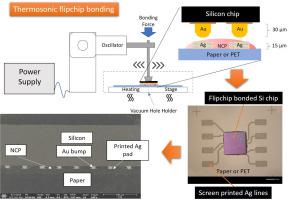当前位置:
X-MOL 学术
›
Microelectron. Eng.
›
论文详情
Our official English website, www.x-mol.net, welcomes your
feedback! (Note: you will need to create a separate account there.)
Thermosonic fine-pitch flipchip bonding of silicon chips on screen printed paper and PET substrates
Microelectronic Engineering ( IF 2.6 ) Pub Date : 2020-05-01 , DOI: 10.1016/j.mee.2020.111330 Ali Roshanghias , Augusto Daniel Rodrigues , Dominik Holzmann
Microelectronic Engineering ( IF 2.6 ) Pub Date : 2020-05-01 , DOI: 10.1016/j.mee.2020.111330 Ali Roshanghias , Augusto Daniel Rodrigues , Dominik Holzmann

|
Abstract In light of the necessity to introduce new techniques for hybrid integration of semiconductor dies on temperature and pressure-sensitive substrates, the feasibility of employing thermosonic flipchip bonding on screen printed paper and PET substrates was the objective of this study. Gold-bumped silicon test chips with internal daisy chain structures were bonded to the corresponding screen printed silver pads on PET and paper substrates by using both thermocompression and thermosonic techniques. The contact resistance of the interconnecting bumps and the die-shear strength of the resulting assembly were evaluated and the optimized bonding conditions on paper and PET substrates were identified. It was proposed that by the introduction of ultrasonic energy, diffusion bonding between the silver flakes and the gold bump were facilitated, whereas in the thermocompression bonding the mechanical interlocking was the main bonding mechanism. As a result, thermosonic flipchip bonding could be conducted in a much shorter time (milliseconds) and at lower bonding pressure (5 N) and temperature (100 °C). It was also found that for screen printed flexible substrates, thermosonic flipchip bonding at lower ultrasonic energy levels is preferential, while the possible bonding-induced damages to the pads and substrates can be avoided. Conclusively, It was proposed that thermosonic flip chip bonding can be regarded as a promising solution for fine-pitch system on paper (SOP) and system on PET (SOPE) technologies.
中文翻译:

硅芯片在丝网印刷纸和 PET 基材上的热超声细间距倒装芯片键合
摘要 鉴于引入半导体芯片在温度和压敏基板上混合集成的新技术的必要性,本研究的目的是在丝网印刷纸和 PET 基板上采用热超声倒装芯片键合的可行性。通过使用热压和热超声技术,将具有内部菊花链结构的金凸点硅测试芯片粘合到 PET 和纸基材上相应的丝网印刷银垫上。评估了互连凸块的接触电阻和所得组件的芯片剪切强度,并确定了纸和 PET 基材上的优化粘合条件。有人提出,通过引入超声波能量,促进了银片和金凸点之间的扩散结合,而在热压粘合中,机械互锁是主要的粘合机制。因此,热超声倒装芯片键合可以在更短的时间(毫秒)和更低的键合压力 (5 N) 和温度 (100 °C) 下进行。还发现,对于丝网印刷的柔性基板,优先采用较低超声波能量水平的热超声倒装芯片键合,同时可以避免键合引起的对焊盘和基板的损坏。最后,有人提出热超声倒装芯片键合可被视为纸上细间距系统 (SOP) 和 PET 系统 (SOPE) 技术的有前途的解决方案。热超声倒装芯片键合可以在更短的时间(毫秒)和更低的键合压力 (5 N) 和温度 (100 °C) 下进行。还发现,对于丝网印刷的柔性基板,优先采用较低超声波能量水平的热超声倒装芯片键合,同时可以避免键合引起的对焊盘和基板的损坏。最后,有人提出热超声倒装芯片键合可被视为纸上细间距系统 (SOP) 和 PET 系统 (SOPE) 技术的有前途的解决方案。热超声倒装芯片键合可以在更短的时间(毫秒)和更低的键合压力 (5 N) 和温度 (100 °C) 下进行。还发现,对于丝网印刷的柔性基板,优先采用较低超声波能量水平的热超声倒装芯片键合,同时可以避免键合引起的对焊盘和基板的损坏。最后,有人提出热超声倒装芯片键合可被视为纸上细间距系统 (SOP) 和 PET 系统 (SOPE) 技术的有前途的解决方案。
更新日期:2020-05-01
中文翻译:

硅芯片在丝网印刷纸和 PET 基材上的热超声细间距倒装芯片键合
摘要 鉴于引入半导体芯片在温度和压敏基板上混合集成的新技术的必要性,本研究的目的是在丝网印刷纸和 PET 基板上采用热超声倒装芯片键合的可行性。通过使用热压和热超声技术,将具有内部菊花链结构的金凸点硅测试芯片粘合到 PET 和纸基材上相应的丝网印刷银垫上。评估了互连凸块的接触电阻和所得组件的芯片剪切强度,并确定了纸和 PET 基材上的优化粘合条件。有人提出,通过引入超声波能量,促进了银片和金凸点之间的扩散结合,而在热压粘合中,机械互锁是主要的粘合机制。因此,热超声倒装芯片键合可以在更短的时间(毫秒)和更低的键合压力 (5 N) 和温度 (100 °C) 下进行。还发现,对于丝网印刷的柔性基板,优先采用较低超声波能量水平的热超声倒装芯片键合,同时可以避免键合引起的对焊盘和基板的损坏。最后,有人提出热超声倒装芯片键合可被视为纸上细间距系统 (SOP) 和 PET 系统 (SOPE) 技术的有前途的解决方案。热超声倒装芯片键合可以在更短的时间(毫秒)和更低的键合压力 (5 N) 和温度 (100 °C) 下进行。还发现,对于丝网印刷的柔性基板,优先采用较低超声波能量水平的热超声倒装芯片键合,同时可以避免键合引起的对焊盘和基板的损坏。最后,有人提出热超声倒装芯片键合可被视为纸上细间距系统 (SOP) 和 PET 系统 (SOPE) 技术的有前途的解决方案。热超声倒装芯片键合可以在更短的时间(毫秒)和更低的键合压力 (5 N) 和温度 (100 °C) 下进行。还发现,对于丝网印刷的柔性基板,优先采用较低超声波能量水平的热超声倒装芯片键合,同时可以避免键合引起的对焊盘和基板的损坏。最后,有人提出热超声倒装芯片键合可被视为纸上细间距系统 (SOP) 和 PET 系统 (SOPE) 技术的有前途的解决方案。











































 京公网安备 11010802027423号
京公网安备 11010802027423号